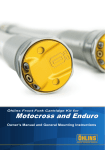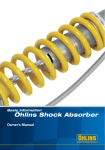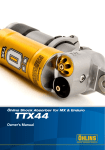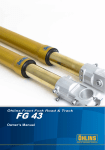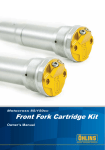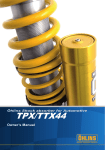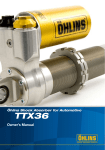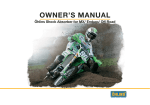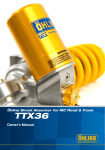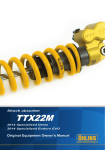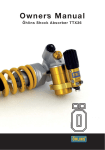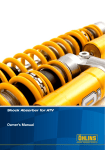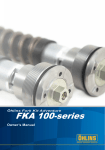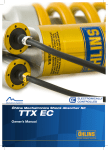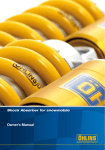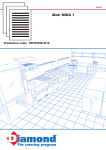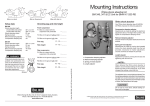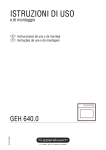Download TPX/TTX44 RER XL52
Transcript
Shock Absorber for Renault Megane R.S. N4 TPX/TTX44 RER XL52 Owner’s Manual Öhlins Racing AB - The Story tles are definitive proof that Öhlins shock absorbers offer outstanding performance and reliability. Every product has gone through rigorous testing and engineers have spent thousands of hours, doing their very best to use every possible experience from our 30 years within the racing sport. By installing this shock absorber on your vehicle you have made a clear statement… you are a serious driver with a focus on getting the maximal handling ability and outstanding feedback from your vehicle. Along comes the fact that your shock absorber will be a long lasting friend, delivering the very best of comfort and performance every time you go for a drive. Go explore! It was the 1970’s, a young man named Kenth Öhlin spent most of his spare time pursuing his favourite sport: motocross. A careful observer, Kenth’s attention was continually drawn to one specific detail - motocross bikes had more engine power than their suspension could handle. It was not long before Kenth realised that better performance could be achieved by improved wheel suspension. Öhlins Racing was established in 1976, and just two years later the company won its first World Championship title. Despite being in the business for 30 years, the search for perfection and new functions is still the main focus of the company. Congratulations! You are now the owner of an Öhlins Shock Absorber. More than three hundred World Championships and other major world ti- In This Manual Safety Precautions Design and Functioning Spring Preload Compression and Rebound Adjust Rebound Adjust Compression Adjustment and Setting Up Inspection and Maintenance Page 2 3 4 5 6 7 8 10 1 Safety Precautions Note! Safety Symbols The shock absorber is a very important part of the vehicle and will affect the stability. In this manual, mounting instructions and other technical documents, important information concerning safety is distinguished by the following symbols: Note! Read and make sure that you understand the information in this manual before you use this product. If you have any questions regarding installation or maintenance please contact an Öhlins dealer. The Safety Alert Symbol means: Warning! Your safety is involved. Warning! Warning! The Warning Symbol means: Failure to follow warning instructions can result in severe or fatal injury to anyone working with, inspecting or using the shock absorber, or to bystanders. Öhlins Racing AB can not be held responsible for any damage to the shock absorber, vehicle, other property or injury to persons, if the instructions for maintenance are not followed exactly. Warning! Caution! This product was developed and designed exclusively for a specific vehicle model and shall only be installed on the intended vehicle model in its original condition as delivered from the vehicle manufacturer. The Caution Symbol means: Special precautions must be taken to avoid damage to the shock absorber. Note! The Note Symbol indicates information that is important regarding procedures. Warning! This product contains pressurized nitrogen gas (N2). Do not open, service or modify this product without proper education (authorized Öhlins dealer/distributor) and proper tools. Note! When working on this product, always consult your Vehicle Service Manual. Warning! After installing this product, take a test drive at low speed to make sure that your vehicle has maintained its stability. Note! This Manual shall be considered a part of the product and shall therefore accompany the product throughout its life cycle. Warning! If the suspension makes an abnormal noise, or the function is irregular, or if you notice any leakage from the product, stop the vehicle immediately and return the product to an Öhlins Service Centre. © Öhlins Racing AB. All rights reserved. Any reprinting or unauthorized use without the written permission of Öhlins Racing AB is prohibited. Printed in Sweden. 2 Design and Functioning Congratulations on choosing the Öhlins TPX/ TX44 Rally shock absorber - the most unique and powerful shock absorber available today. The TPX44 in the front is a twin piston type shock absorber whereas the TTX44 in the rear is a twin tube type. The TPX44 is three way adjusted, high and low speed compression adjuster and rebound. The TTX44 is four way adjusted, it has the high and low speed compression adjuster and due to its design it features a main rebound adjuster and a fine tune adjuster. Both shock absorbers are equipped with the new updated Progressive Damping System (PDS). The TPX/ TTX44 shock absorber design is the culmination of two decades of Öhlins successful participation in World Championship events. The Öhlins TPX/ TTX44 features patent pending concept with a unique design, that allows for the gas pressure to always back-up the lowpressure side of the piston to keep pressure at a controlled level. Both concepts enable totally separated adjusters for compression and rebound damping. The temperature stability is maintained by using a flow restriction design in the bleed valves that create a turbulent flow at very low piston velocities. Also, materials with different thermal expansion rates are used to compensate for the viscosity change of the fluid caused by changes in temperature. The Öhlins shim system offers infinite combinations of shim stacks with a wide spectrum of different character using only one piston. The whole system is pressurized by nitrogen gas behind a floating piston to ensure separation of gas and fluid. The Öhlins TPX/ TTX44 shock absorbers are racer friendly shock absorbers, easy to set up, dial in and rebuild. Support is always available from the Öhlins distributors worldwide. The TPX/ TTX44 shock absorbers are designed to handle the demanding damping characteristics needed for all types of roads on which the car is aimed to compete on. For best performance, the shock absorber must be adjusted to different conditions; for the smooth and fast tarmac roads seen in some rallies to the more bumpy and twist seen in others. TPX44 - front TTX44 - rear 3 Spring Preload When adjusting the spring preload you move the spring seat. This will lower or raise the vehicle ride height. The ride height is important for the behavior of your vehicle. TPX Shock Absorber Note! The correct C-spanners are delivered with the dampers. 1 2 Set the Spring Preload TPX Shock Absorber 1.Use two C-spanners to undo the lock nut. 2.Turn the spring platform to the desired position. 3.After adjusting, lock the lock nut. 3 Note! 1[one] turn of the spring platform changes front ride height with 2.1mm TTX Shock Absorber 1.Unlock the screw on the spring platform clamp. 2.Use a C-spanner to adjust the platform to the desired position. 3.Tighten the screw on the spring platform clamp. TTX Shock Absorber Note! 1[one] turn of the spring platform changes rear ride height with 2.8mm 1 3 2 4 Compression and Rebound Compression and Rebound Damping Compression damping controls the energy absorption when the shock absorber is being compressed, thus controls how easy the shock absorber compresses when you hit a bump. Rebound damping controls the energy absorption when the shock absorber is being extended and controls how fast the shock absorber returns to its normal position after being compressed. Rebound Damping Adjuster Rebound adjuster affects chassis movement in a similar way as the low speed compression but has even more influence on traction. Use this adjuster to control chassis movements over crests or after jumps. More rebound gives less movement and better stability but too much will cause a loss of traction. It is therefore a powerful balance tool together with the low speed compression adjuster. For slippery conditions when grip levels are low, a softer set up on both rebound and low speed compression is a way to gain more traction. Compression Damping Adjuster Low speed compression is mainly used to control chassis movements and response but it also affects the traction. It affects how the car behaves during breaking, turn in and acceleration. Less low speed compression gives more chassis movement but in many cases it can improve traction and grip. Therefore it is possible to balance the car by adjusting the low speed compression. High speed compression mainly affects how the car absorbs bumps and jumps. In rougher conditions or with a lot of jumps more high speed damping is often necessary to control the big chassis movements. 5 Adjust rebound Rebound Damping Adjuster TPX Shock Absorber TPX44 Shock Absorber To adjust rebound damping: 1.Use a long 3 mm allen key or tool 01743-01 (delivered with the product). 2.Turn the adjuster clockwise to fully closed position (position zero [0]). 3.Turn counter clockwise to set the adjuster to recommended number of clicks (see Recommended Set Up in this manual). 4.If you want to change setting, adjust in steps of 2-3 clicks at a time. Useful adjustment range 2 3 1 5-30 clicks or Caution! Do not use force, delicate sealing surfaces can be damaged. Handtighten only. TTX44 Shock Absorber The TTX44 has two rebound adjusters due to its unique design of twin tube layout and temperature stability valve design. The adjuster in the shaft end eye is the main adjuster and the one in the cylinder head is the fine tuning. 1 or TTX Shock Absorber To adjust rebound damping: 1.Use a 3 mm allen key or tool 01822-02 (delivered with the product). 2.Turn the adjuster clockwise to fully closed position (position zero [0]). 3.Turn counter clockwise to set the adjuster to recommended number of clicks (see Recommended Set Up in this manual). 4.If you want to change setting, adjust in steps of 2-3 clicks at a time (both main and fine tune). 2 3 Useful adjustment range main 5-30 clicks fine 2-15 clicks 2 Caution! 3 Do not use force, delicate sealing surfaces can be damaged. Handtighten only. 6 adjust compression Compression Damping Adjuster (TPX/TTX) To adjust: 1.High speed compression adjuster; Use a 12 mm wrench Low speed compression adjuster; Use a 3 mm Allen key 2.Turn the adjuster clockwise to fully closed position (position zero [0]). 3.Turn counter clockwise to set the adjuster to recommended number of clicks (see Recommended Set up). 4.If you want to change setting, High speed compression; adjust in steps of 3-5 clicks to fine tune the set up. Low speed compression; adjust in steps of 2-3 clicks at a time. Useful adjustment range low speed 2-40 clicks high speed 0-50 clicks High speed compression adjuster 1 3 2 Low speed compression adjuster 1 3 2 Caution! Do not use force, delicate sealing surfaces can be damaged. Handtighten only. High speed compression adjuster 1 3 2 Low speed compression adjuster 1 3 2 7 Adjustment and Setting Up Spring set-up A number of springs are available to suit all different conditions and driving styles. See below a list of recommended springs (stiffness and part number). Recommended Set up Note! Always start with the settings recommended by Öhlins and Renault Sport Technologies. Spring list At delivery the dampers are set according to the following; RER 1- and 2L52 Low speed compression High speed compression Rebound Spring (part no 06774-23) RER 6L52 Low speed compression High speed compression Main rebound Fine tune rebound Spring (part no 06320-19) 10 clicks 20 clicks 10 clicks 80 N/mm RER 1- and 2L52 70 N/mm, 06774-19 75 N/mm, 06774-21 80 N/mm, 06774-23 (std) 85 N/mm, 06774-25 90 N/mm, 06774-27 24 clicks 27 clicks 12 clicks 6 clicks 70 N/mm RER 6L52 60 N/mm, 06320-14 66 N/mm, 06320-17 70 N/mm, 06320-19 (std) 75 N/mm, 06320-21 80 N/mm, 06320-24 Note! If you need support to find your own optimal setup, please contact an Öhlins Service Centre or your Renault Sport Technologies Contact. Setting up your vehicle Note! After installing the dampers, do a complete set up check of the car according to Renault Sport set up recommendations. Perform the following steps and always take notes before using the shock absorber; • Check ride height, front and rear. Adjust if necessary. • Check corner weight, front and rear (if scales are available). Adjust if necessary. Note! Always consult your Öhlins dealer if you have any questions regarding settings of the shock absorber/strut. 8 Adjustment and Setting Up When making adjustments • Take notes, make the adjustments in small steps (2-3 at a time) and stay within the recommended adjustment range. • When you think you have made an improvement, go back to what you started with and double check to be sure. • Pay attention to changes in conditions like tires or temperature, etc. In general, compression damping changes should be used to influence the vehicle’s response and balance while rebound damping changes should be used to influence traction and stability. • When you need more damping force in the front, first try to increase compression damping and use as little rebound damping as possible. This usually means that you improve response and handling performance but keep traction. For the rear, more compression reduces exit understeer and more rear rebound can help turn in and first part of the corner. Making adjustments Suspension settings depend on your vehicle’s weight, your driving style, road conditions etc. If you are not happy with our recommended settings, here are a few guidelines and ground rules how to make adjustments. To make improvements, it is important to understand the function of the shock absorbers and through testing learn how they affect the handling of your vehicle. Note! Higher click numbers give less damping force. inspection and maintenance Inspection and Maintenance Preventive maintenance and regular inspection reduces the risk of functional disturbance. If there is any need for additional service, please contact an authorized Öhlins Service Centre. Inspection points TPX/TTX - Normal use 1. Check ball joints/ brackets for possible excessive play or stiction. 2. Check the piston shaft for damage that can cause leakage. 3. Check the shock absorber body for external damage. 4. Check the external reservoir for damage that can restrict the floating piston from moving freely. 5. Make sure that the reservoir is protected against stone chip. 6. Check the attachment of the shock absorber to the vehicle. Cleaning Clean the shock absorber externally with a soft detergent. Use compressed air. Be careful that all dirt is removed. Lift the bump rubber and clean the area below. Keep the shock absorber clean and spray it with oil (WD40, CRC 5-56 or equivalent) after washing. Wipe off excessive oil with a cloth. Caution! Never spray water directly into the adjuster knobs and/or the ball joints. 9 Inspection and Maintenance Inspection points TPX44 - Every 300-400 km 1. Use C-spanner part no. 01897-01. Remove the scraper holder from the outer tube. Cover the circlip groove at the top of the cylinder tube with tape and pull the scraper holder off the cylinder tube - see figure. 2. Clean the scraper, from dirt and grease. Check it for wear and/or damage and change if necessary, part no 05502-06. 3. Apply a layer of Öhlins red grease, part no. 00146-0X on the scraper and in the groove in the scraper. 4. Mount the scraper holder on the outer tube. Tighten with C-spanner. Tightening torque 20 Nm Use Loctite 278 (on the scraper holder) 1 Removing the scraper holder (TPX only) Tool 01897-01 Note! To increase the life of the bushings and reduce friction it is possible to remove the strut casing but that is of the responsibility of the customer. To clamp the strut; use Renault Alpine tool ref 77 11 167 262. To remove the bottom nut; use tool ref 77 11 167 261. Caution! When removing the bottom make sure not to clamp around the anti roll-bar bracket. Clean the bushings. Put red grease (00146‑xx) on and between the bushings. Take note of the circlip position in the strut casing when assembling the strut, the reservoir bracket should pass through the opening in the circlip. Tightening torque 40Nm (no Loctite) Note! For more information contact Renault Sport Technologies or your local Öhlins service centre. Tape Scraper holder Renault Alpine tool reference 77 11 167 261 Service Interval TPX/TTX Every 1000km Service your damper(s) at an Öhlins Service Centre. If the dampers are used under more rough tarmac conditions, maintenance could be required more frequently. Warning! Never alter the gas pressure. Special purpose charging equipment and access to nitrogen is required. The gas pressure should normally never be altered. 10 Öhlins Owner’s Manual RERXL52 | Part No. 07440-04_0 | Issued 2011-04-06 | © 2011 Öhlins Racing AB Your Öhlins retailer: Öhlins Racing AB Box 722 SE-194 27, Upplands Väsby Sweden Phone: +46 (0)8 590 025 00 Fax: +46 (0)8 590 025 80 www.ohlins.com












